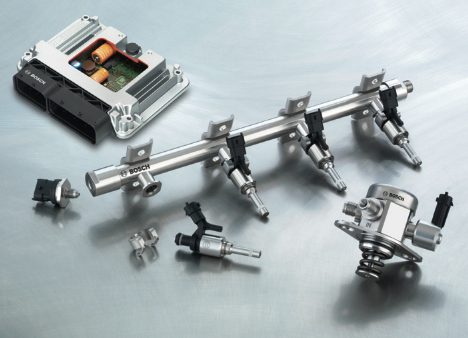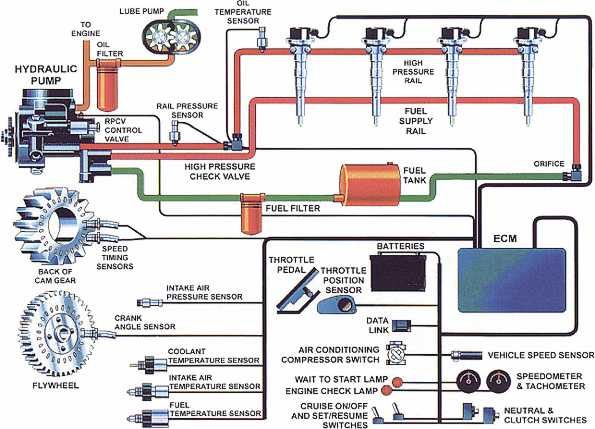Electronic fuel injection (EFI) systems are the most common type of fuel injection used in modern cars. EFI systems are used to deliver fuel to the engine in a precise and controlled manner, resulting in better fuel economy, more power, and reduced emissions. In this blog post, we’ll take a closer look at the components of an electronic fuel injection system.
- Fuel pump: The fuel pump is responsible for delivering fuel from the gas tank to the fuel injectors. EFI systems typically use an electric fuel pump, which is controlled by the engine’s electronic control module (ECM). The fuel pump must be able to deliver fuel at a consistent pressure and volume, regardless of the engine’s speed or load.
- Fuel injectors: Fuel injectors are responsible for delivering fuel into the engine’s combustion chamber. EFI systems use one injector per cylinder, and each injector is controlled by the engine’s ECM. The ECM determines how much fuel to inject based on input from various sensors, such as the throttle position sensor and the oxygen sensor.
- Fuel pressure regulator: The fuel pressure regulator is responsible for maintaining a consistent fuel pressure throughout the EFI system. It does this by regulating the amount of fuel that is returned to the gas tank. If the fuel pressure is too high, the regulator will allow more fuel to flow back to the gas tank. If the fuel pressure is too low, the regulator will restrict the amount of fuel that is returned to the gas tank.
- Throttle body: The throttle body is responsible for controlling the amount of air that enters the engine. EFI systems use an electronic throttle body, which is controlled by the engine’s ECM. The ECM determines how much air to allow into the engine based on input from various sensors, such as the throttle position sensor.
- Sensors: EFI systems rely on various sensors to provide the ECM with information about the engine’s operating conditions. Some of the most important sensors include the oxygen sensor, which measures the amount of oxygen in the exhaust, and the mass air flow sensor, which measures the amount of air entering the engine.
- Electronic control module (ECM): The ECM is the “brain” of the EFI system. It receives input from various sensors and uses this information to control the fuel injectors, throttle body, and other components of the EFI system. The ECM also monitors the system for faults and stores diagnostic codes if a fault is detected.
In conclusion, electronic fuel injection systems are complex systems that rely on many different components working together to deliver fuel to the engine in a precise and controlled manner. The fuel pump, fuel injectors, fuel pressure regulator, throttle body, sensors, and ECM all play critical roles in the EFI system. By working together, these components help to improve fuel economy, increase power, and reduce emissions.

- Fuel pump: The fuel pump is an essential component of the EFI system because it delivers fuel from the gas tank to the fuel injectors. EFI systems use an electric fuel pump, which is typically located in or near the gas tank. The fuel pump must be able to deliver fuel at a consistent pressure and volume, regardless of the engine’s speed or load. To achieve this, the fuel pump is controlled by the engine’s electronic control module (ECM). The ECM sends signals to the fuel pump to adjust the fuel pressure and volume as needed.
- Fuel injectors: Fuel injectors are responsible for delivering fuel into the engine’s combustion chamber. EFI systems use one injector per cylinder, and each injector is controlled by the engine’s ECM. The ECM determines how much fuel to inject based on input from various sensors, such as the throttle position sensor and the oxygen sensor. The injectors are mounted in the intake manifold, and they spray fuel into the engine’s intake ports. The fuel is then mixed with air and ignited in the combustion chamber.
- Fuel pressure regulator: The fuel pressure regulator is a critical component of the EFI system because it ensures that the fuel pressure remains consistent throughout the system. The fuel pressure regulator is typically located on the fuel rail, which is a pipe that connects the fuel injectors. The fuel pressure regulator works by regulating the amount of fuel that is returned to the gas tank. If the fuel pressure is too high, the regulator will allow more fuel to flow back to the gas tank. If the fuel pressure is too low, the regulator will restrict the amount of fuel that is returned to the gas tank. This allows the fuel pressure to remain constant regardless of the engine’s speed or load.
- Throttle body: The throttle body is responsible for controlling the amount of air that enters the engine. EFI systems use an electronic throttle body, which is controlled by the engine’s ECM. The throttle body is mounted on the intake manifold, and it contains a butterfly valve that opens and closes to control the amount of air that enters the engine. The ECM determines how much air to allow into the engine based on input from various sensors, such as the throttle position sensor. By controlling the amount of air that enters the engine, the throttle body helps to ensure that the air-fuel mixture is optimized for the engine’s operating conditions.
- Sensors: EFI systems rely on various sensors to provide the ECM with information about the engine’s operating conditions. Some of the most important sensors include the oxygen sensor, which measures the amount of oxygen in the exhaust, and the mass air flow sensor, which measures the amount of air entering the engine. The ECM uses this information to adjust the fuel and air mixture to optimize performance, fuel economy, and emissions.
- Electronic control module (ECM): The ECM is the “brain” of the EFI system. It receives input from various sensors and uses this information to control the fuel injectors, throttle body, and other components of the EFI system. The ECM also monitors the system for faults and stores diagnostic codes if a fault is detected. By constantly adjusting the fuel and air mixture based on the engine’s operating conditions, the ECM helps to ensure that the engine runs smoothly and efficiently.
In summary, each component of an EFI system plays a critical role in delivering fuel to the engine in a precise and controlled manner. By working together, these components help to improve fuel economy, increase power, and reduce emissions. EFI systems are complex systems, but they offer many benefits over traditional carbureted systems, including improved performance, reliability, and efficiency.
Advantages:
- Improved fuel efficiency: EFI systems provide better fuel efficiency compared to carbureted systems because they can more precisely control the amount of fuel injected into the engine.
- Increased power: EFI systems can provide increased power output compared to carbureted systems due to their ability to more precisely control the air-fuel mixture.
- Better emissions control: EFI systems help to reduce harmful emissions by more precisely controlling the air-fuel mixture and by incorporating emissions control devices, such as catalytic converters and oxygen sensors.
- Improved reliability: EFI systems are more reliable than carbureted systems because they do not rely on mechanical components to deliver fuel to the engine.
- Reduced maintenance: EFI systems require less maintenance than carbureted systems because they do not have carburetor jets or other components that can become clogged with dirt or debris.
Disadvantages:
- More complex: EFI systems are more complex than carbureted systems, which can make them more difficult to diagnose and repair when problems occur.
- Higher cost: EFI systems are more expensive than carbureted systems due to their more complex design and electronic components.
- More sensitive to voltage fluctuations: EFI systems are more sensitive to voltage fluctuations than carbureted systems, which can cause problems with the fuel pump or other components.
- Limited adjustability: EFI systems have limited adjustability compared to carbureted systems, which can make it more difficult to tune the engine for maximum performance.
- Need for specialized equipment: EFI systems require specialized equipment to diagnose and repair problems, which can make it more difficult for DIY mechanics to work on their own vehicles.
Overall, the advantages of EFI systems outweigh the disadvantages for most applications. EFI systems provide improved fuel efficiency, increased power, and better emissions control compared to carbureted systems, which makes them the preferred choice for modern engines. However, EFI systems are more complex and expensive than carbureted systems, which may be a consideration for those on a tight budget or who prefer to do their own vehicle maintenance.









